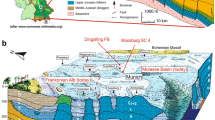Abstract
Petrophysical data on heterogeneous dolostone rocks of the San Andres Formation (Permian) of West Texas were obtained using a mercury porosimeter from two kinds of samples: (a) cylindrical core plugs and (b) chips (simulated well-cuttings). In both kinds of samples, dolomitized oolitic grainstones and dolomudstones showed characteristics of good reservoir rocks (medium to large, uniform-sized pore throats, and a high percentage of available pores). Data from both plug and chip samples yielded comparable capillary-pressure curves defining the tight caprock facies and locating the top of the porosity zone in the dolomudstone. Petrophysical data derived from plugs and chips are similar because micron-sized throats which control capillary effects are not affected by sampling processes. The experiments suggest that well-cuttings, which are inexpensive to collect, can provide representative samples for characterization of reservoir facies in the thick, heterogeneous carbonate sequence of the San Andres. Well-cuttings therefore deserve more attention as an alternative sampling material, especially in reservoirs where cores are not available.
Similar content being viewed by others
References
BROWN, H. W., 1951, Capillary pressure investigations: Petrol. Trans. (AIME), v. 192, p. 67–74.
DULLIEN, F. A. L., 1979, Porous media, fluid transport and pore structure. Academic Press, 396 p.
FRIEDMAN, G. M., RUZYLA, K., and REECKMANN, A., 1981. Effects of porosity type, pore geometry and diagenetic history on the tertiary recovery of petroleum from carbonate reservoirs: Rept. No. DOE/MC/-11580-5, U. S. Dept. of Energy, National Tech. Information Service, U. S. Dept. of Commerce, Springfield, VA, 217 p.
JODRY, R. L., 1972, Pore geometry of carbonate rocks, basic geologic concepts, in, Chilingar, G. V., Mannon, R. W., and Rieke, H. H., eds., Oil and gas production from carbonate rocks. Elsevier, p. 35–82.
KOPASKA-MERKEL, D. C., AMTHOR, J., and FRIEDMAN, G. M., in press, Notes on the use of a mercury porosimeter (Micromeritics Pore Sizer 9305): Northeastern Science Foundation Technical Report 1, Northeastern, Science Foundation, 10 p.
PURCELL, W. R., 1949, Capillary pressure — their measurement using mercury and calculation of permeability therefrom: Jour. Petrol. Trans. (AIME), v. 1, Tech. Paper 2544, p. 39–48.
RUZYLA, K. and FRIEDMAN, G. M., 1982, Geological heterogeneities important to future enhanced recovery in carbonate reservoirs of Upper Ordovician Red River Formation at Cabin Creek field, Montana: Soc. Petrol. Engr., v. 22, p. 429–44.
THOMEER, J. H. M., 1960, Introduction of a pore geometrical factor defined by the capillary pressure curve: Jour. Petrol. Tech., (AIME), v. 219, Tech. note no. 2057, p. 73–77.
WARDLAW, N. C., 1980, The effects of pore structure on displacement efficiency in reservoir rocks and in glass micromodels: Jour. Soc. Petrol. Engr., No. 8843, p. 345–52, (Paper presented at the First SPE/DOE Symposium on enhanced oil recovery, Tulsa, OK).
—, and CASSAN, J. P., 1978, Estimation of recovery efficiency by visual observation of pore systems in reservoir rocks: Bull. Can. Petrol. Geol., v. 26, p. 527–85.
— and CASSAN, J. P. 1979, Oil recovery efficiency and the rock-pore properties of some sandstone reservoirs: Bull. Can. Petrol. Geol., v. 27, p. 117–38.
Author information
Authors and Affiliations
Rights and permissions
About this article
Cite this article
Ghosh, S.K., Urschel, S.F. & Friedman, G.M. Substitution of simulated well-cuttings for core plugs in the petrophysical analysis of dolostones: Permian San Andres Formation, Texas. Carbonates Evaporites 2, 95–100 (1988). https://doi.org/10.1007/BF03174309
Published:
Issue Date:
DOI: https://doi.org/10.1007/BF03174309




